
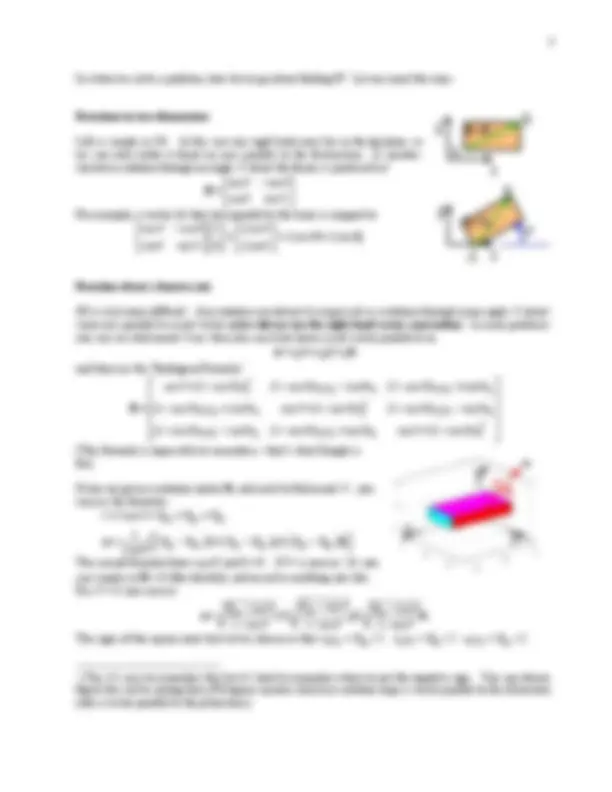
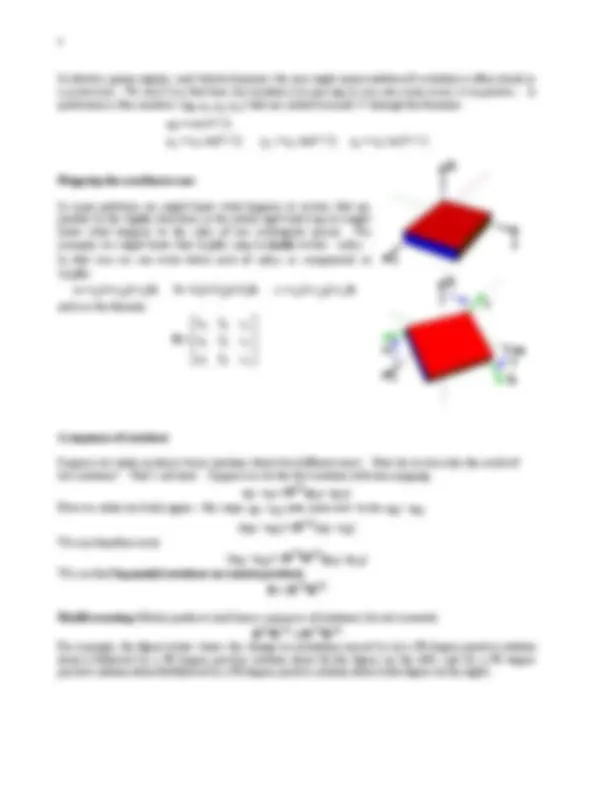
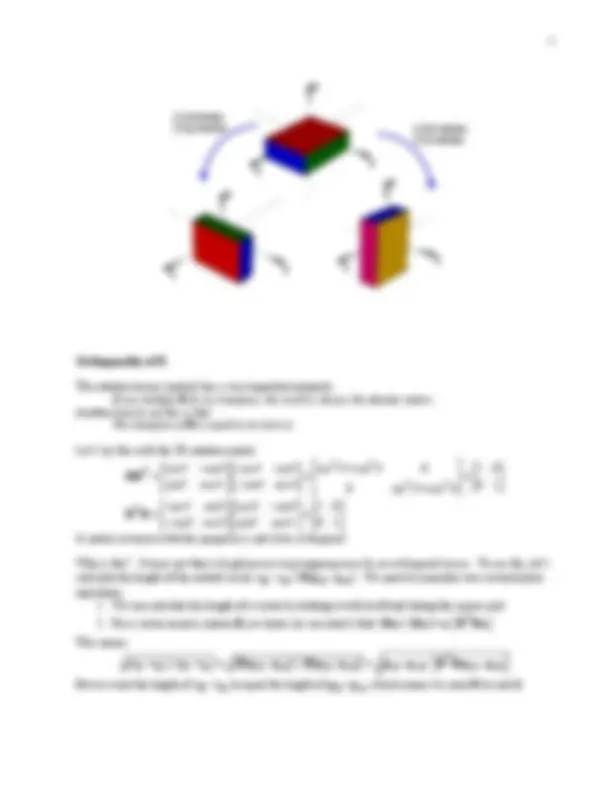
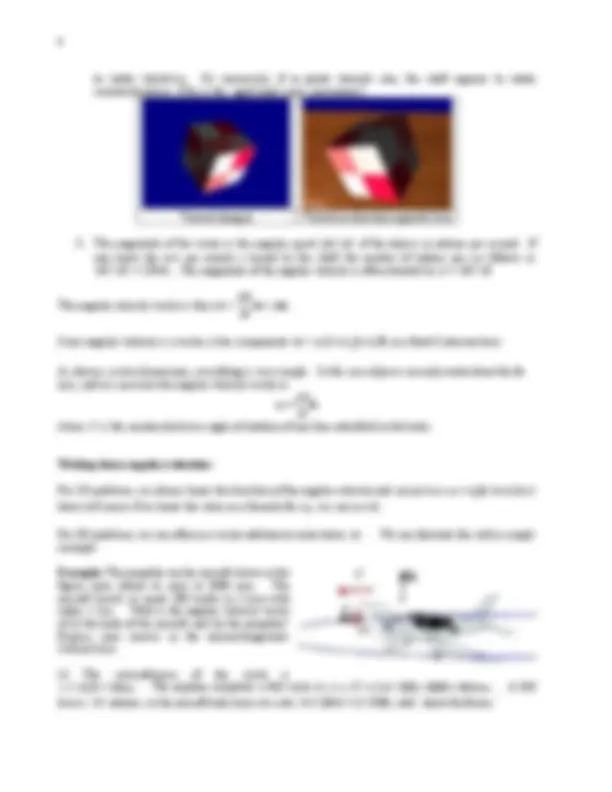
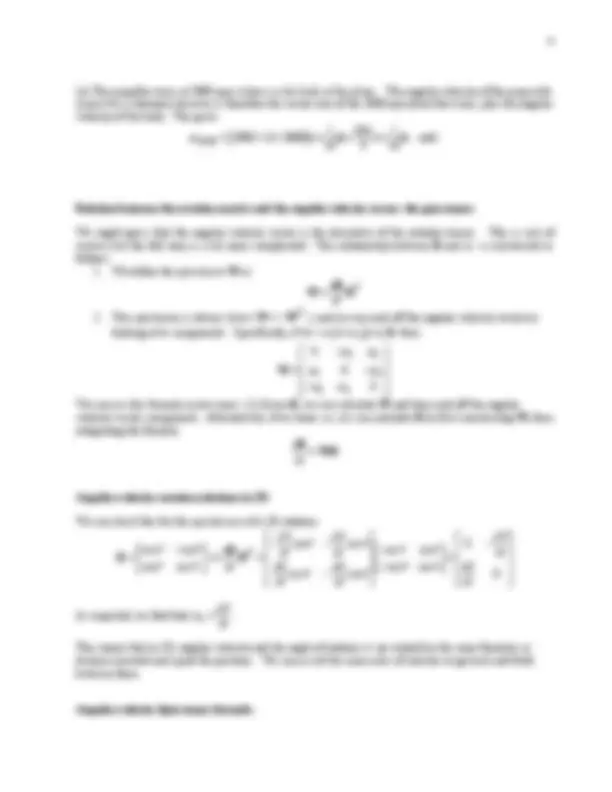
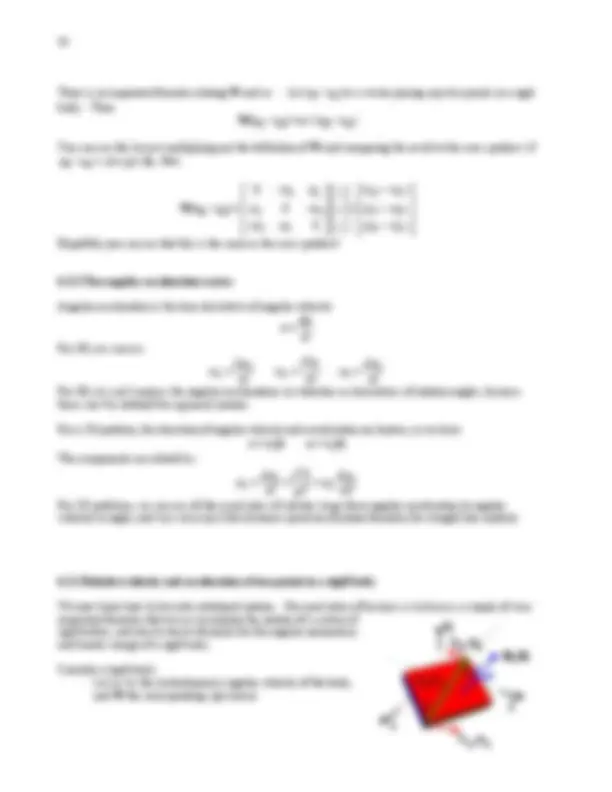
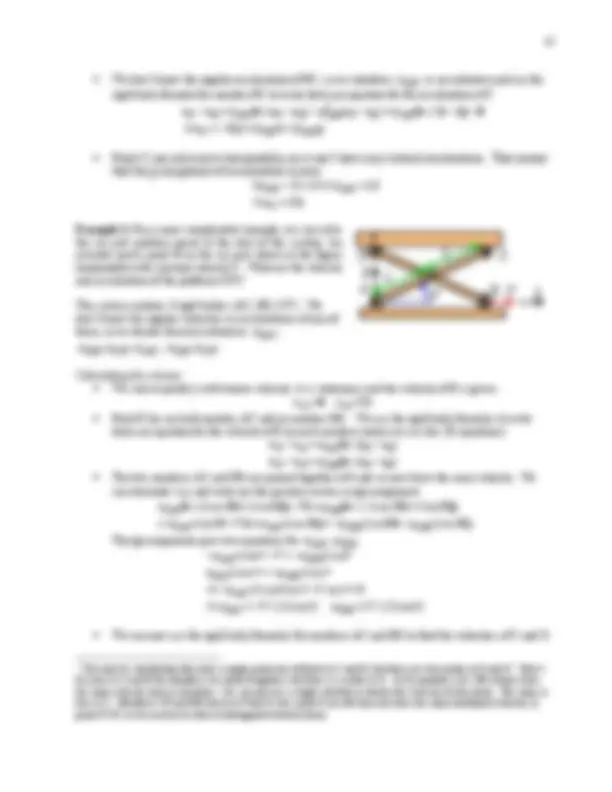
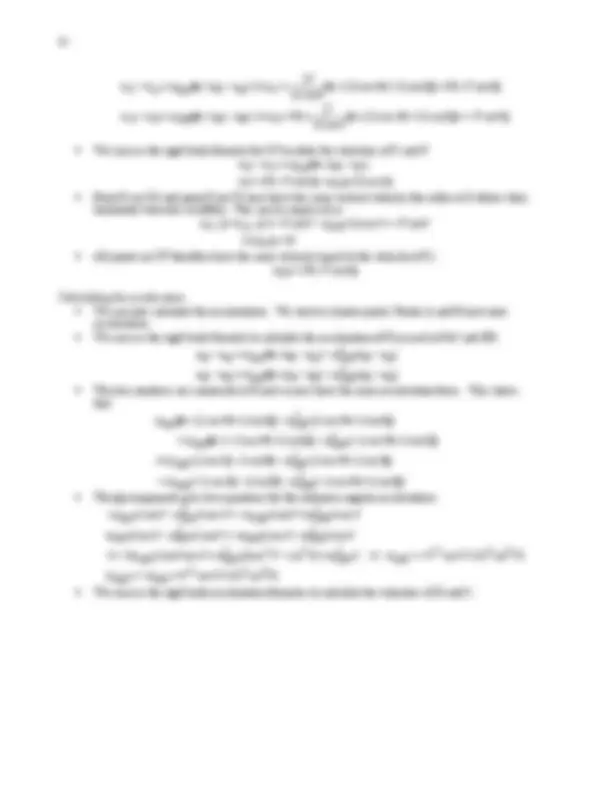
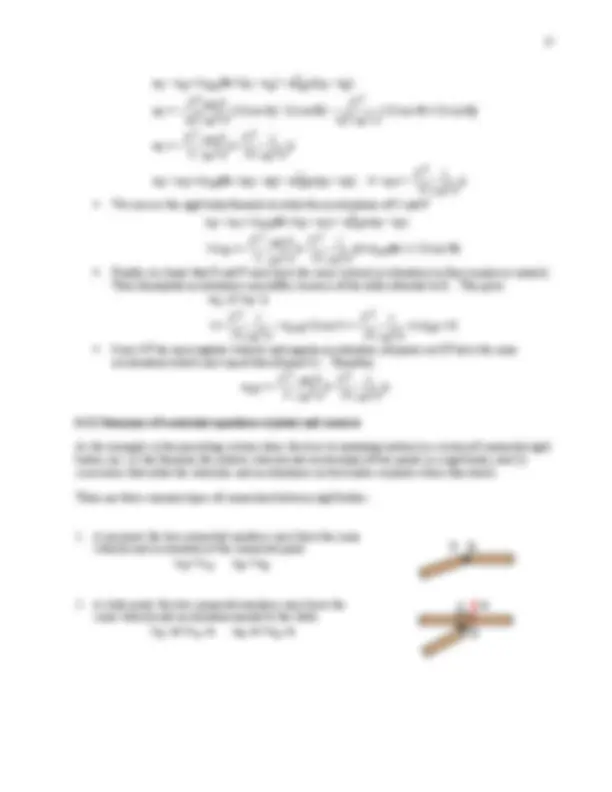
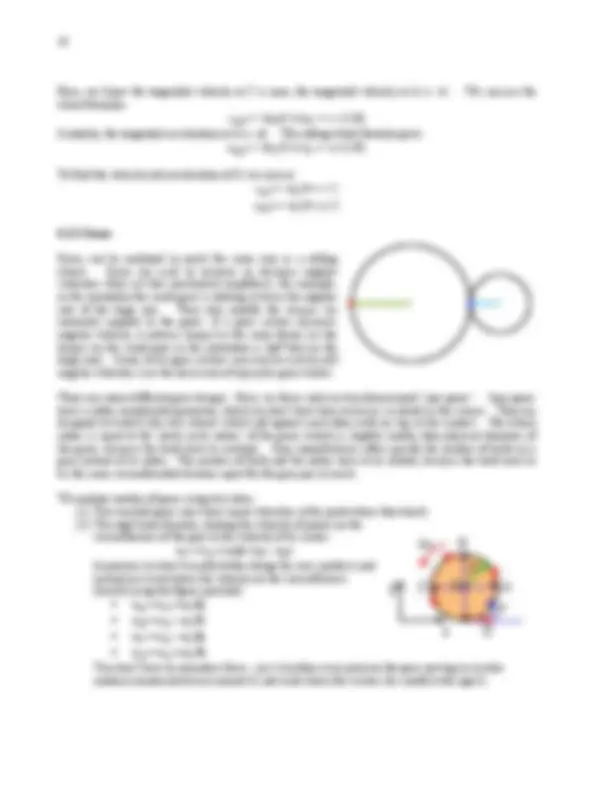
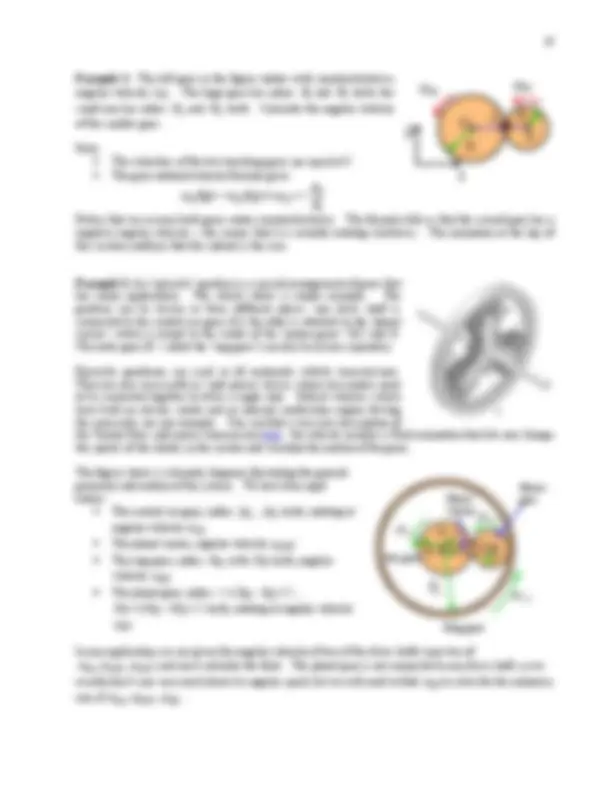
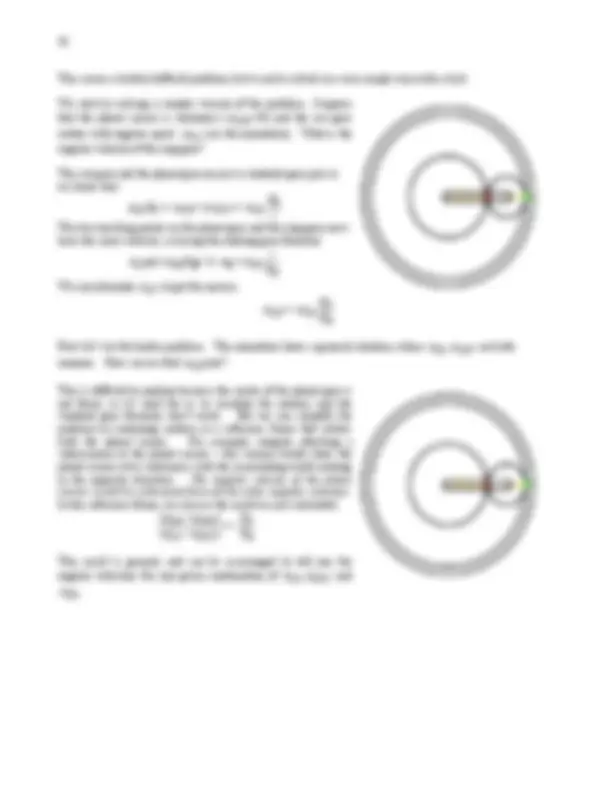
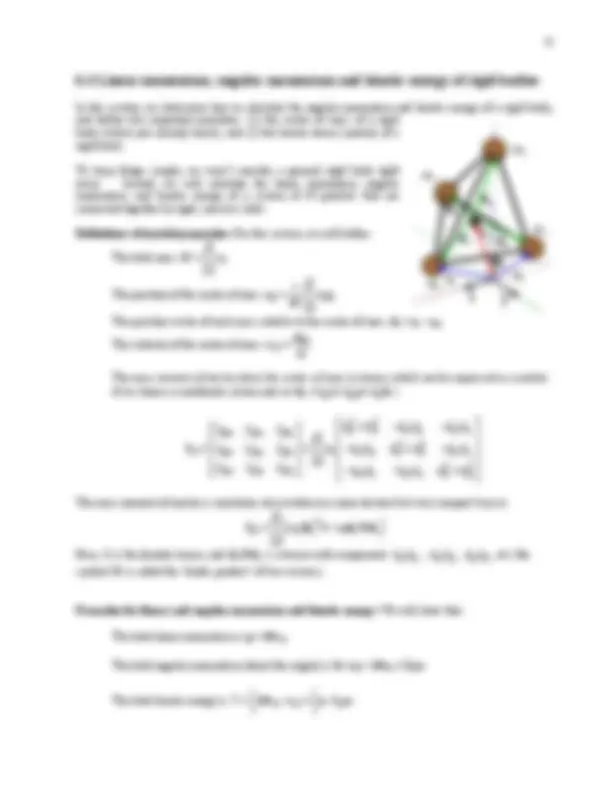
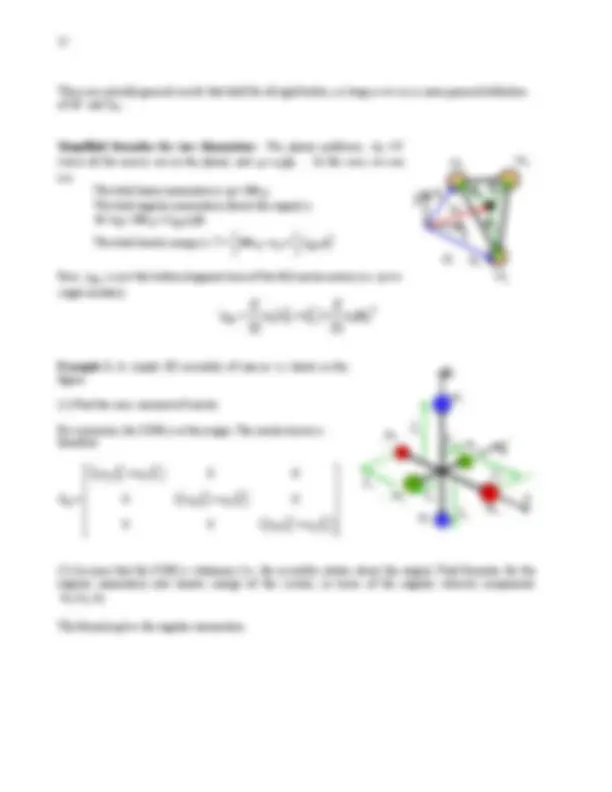
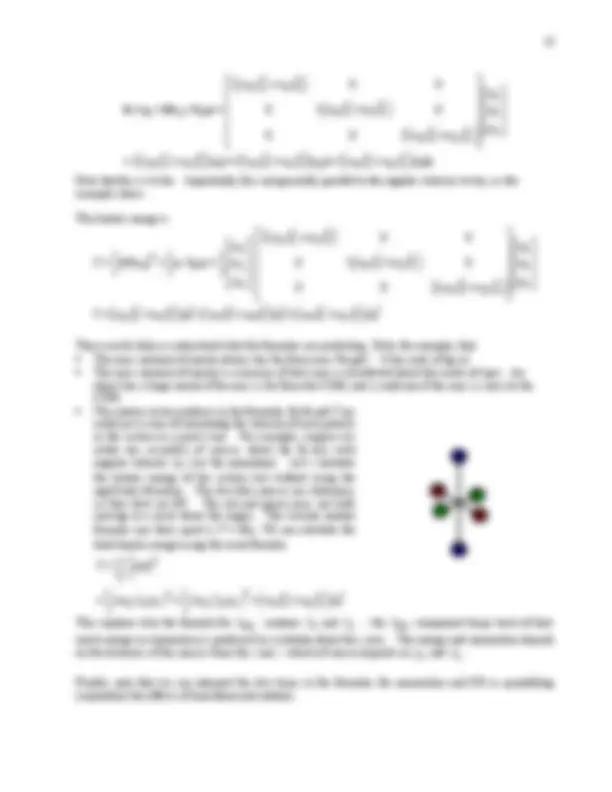
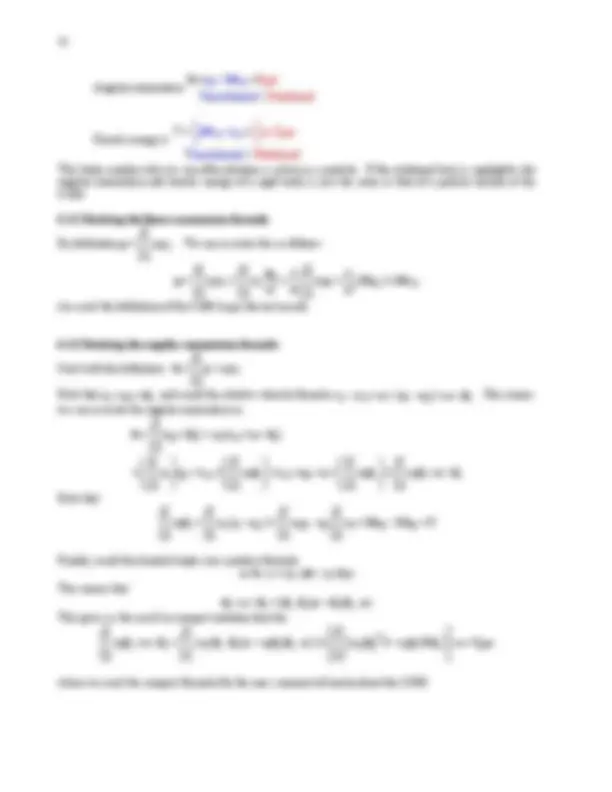
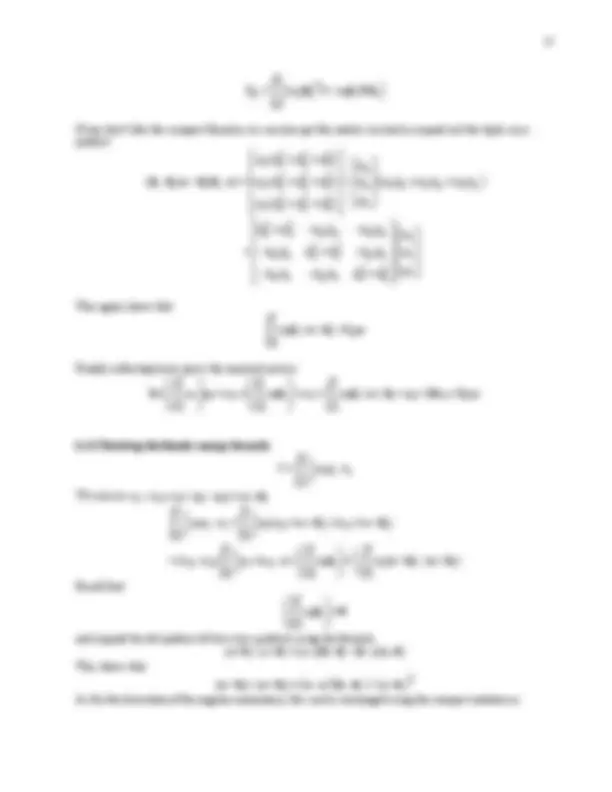
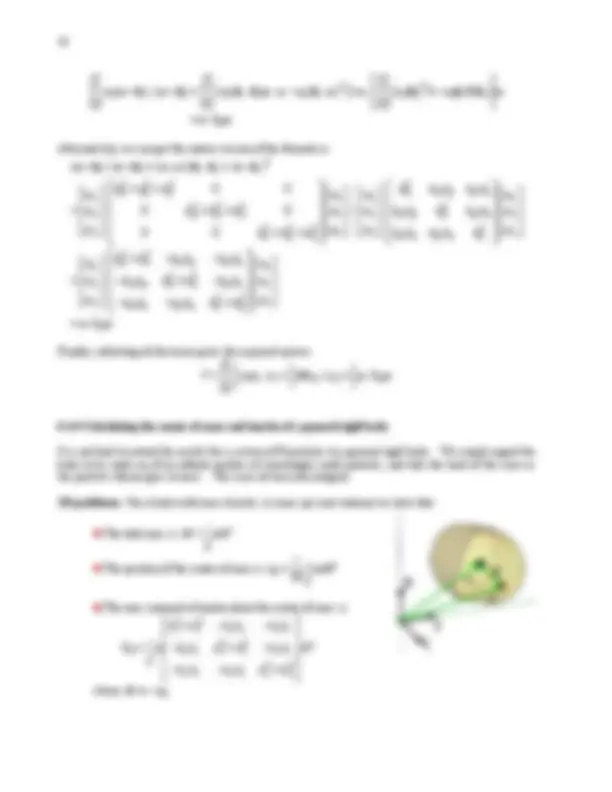
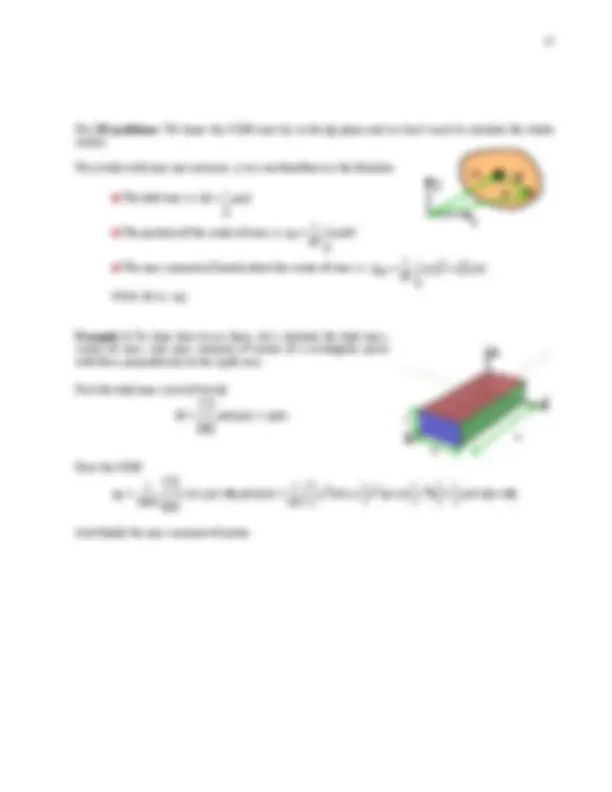
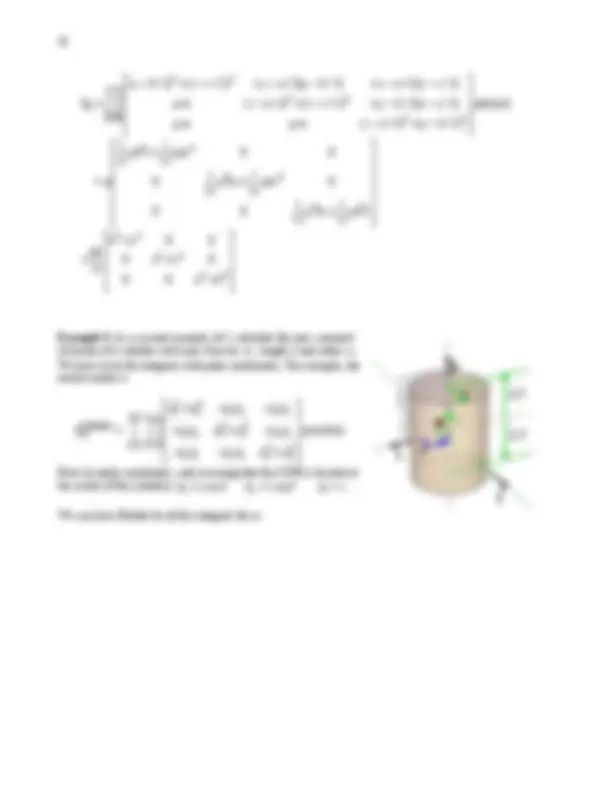
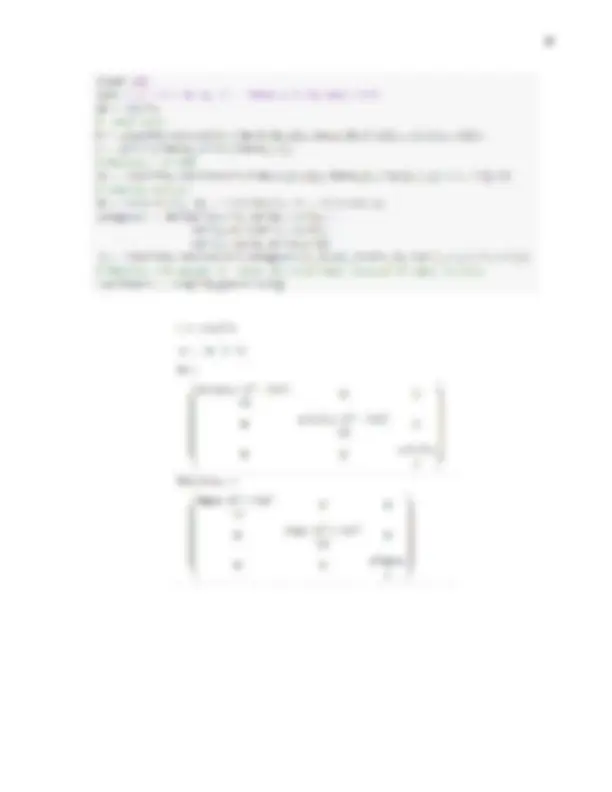
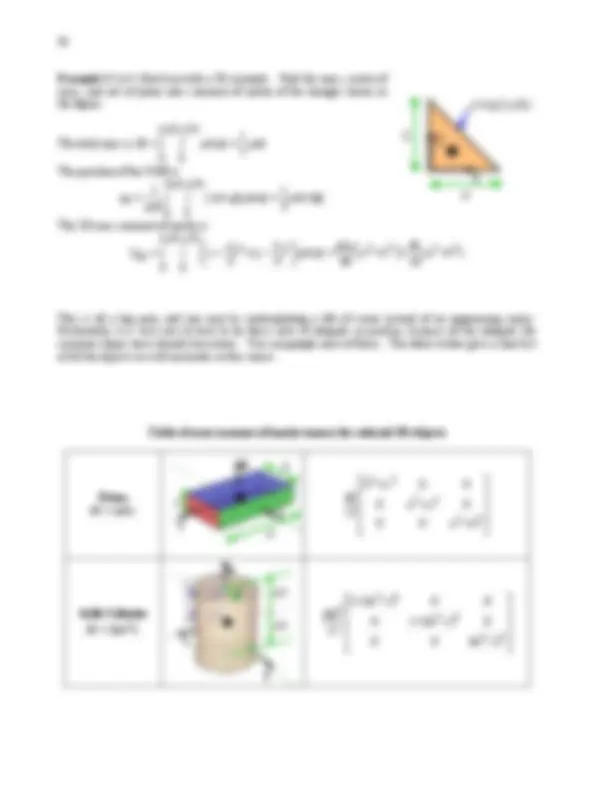
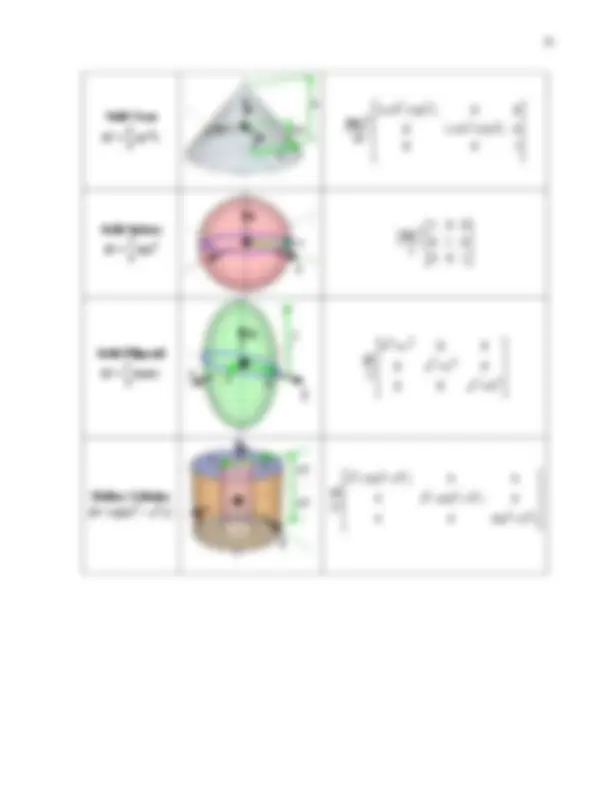
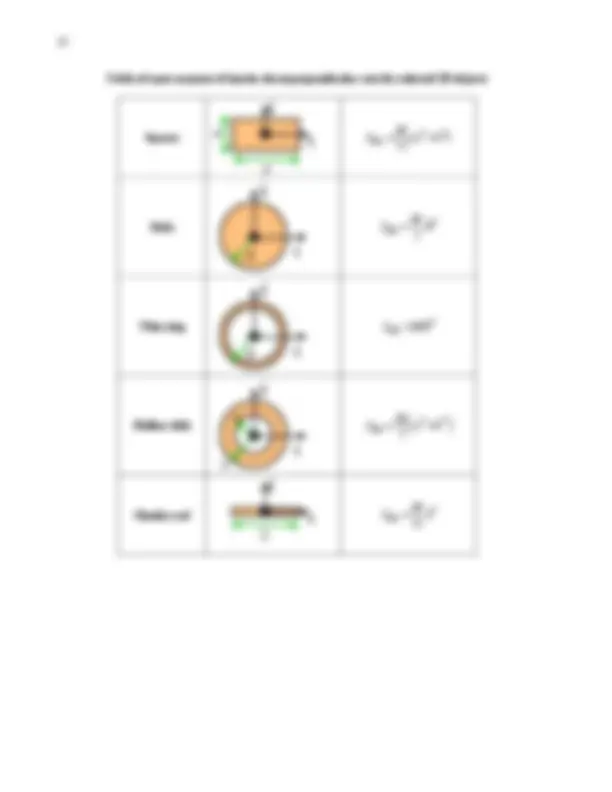
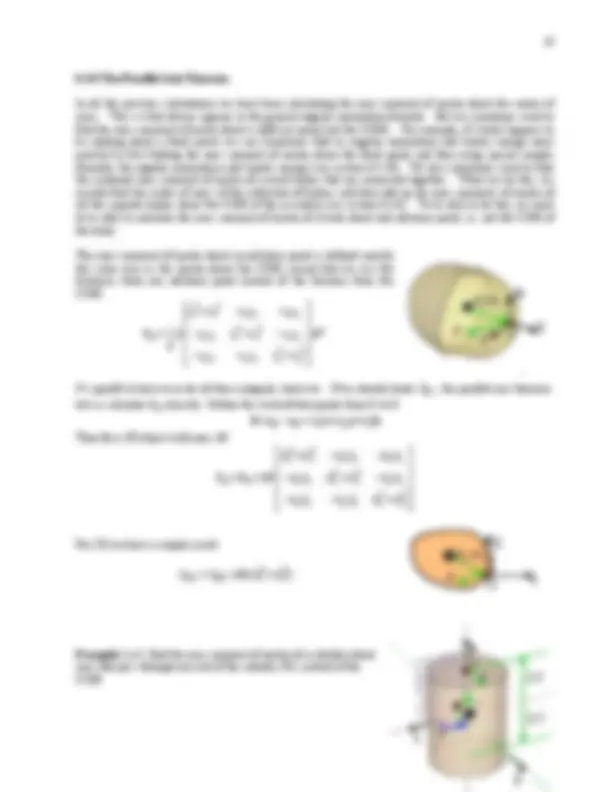

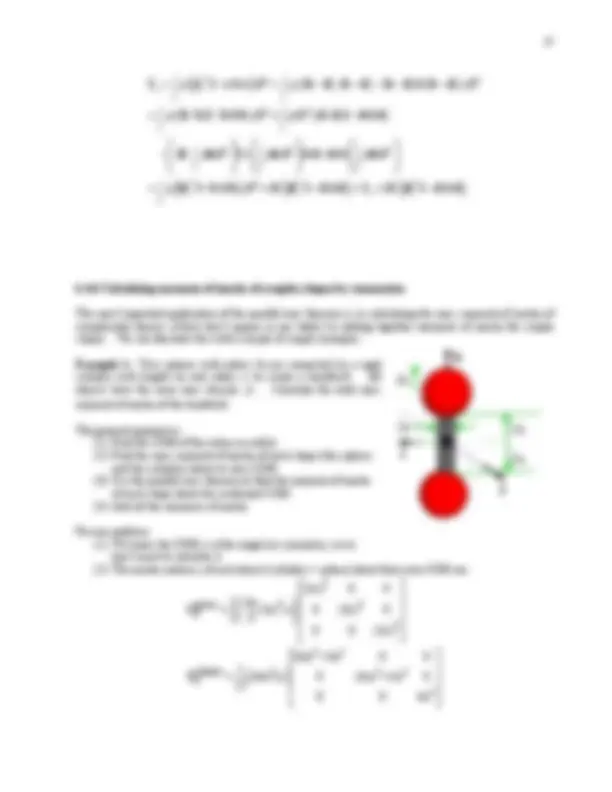
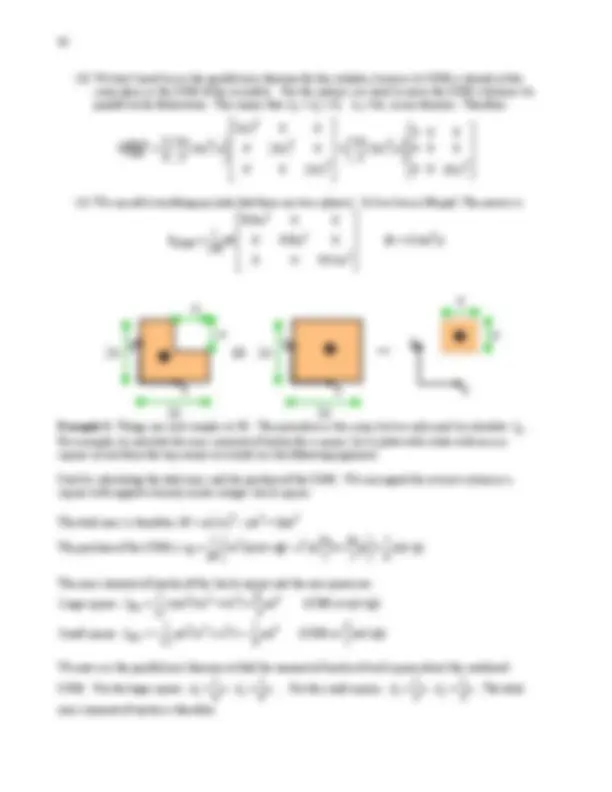
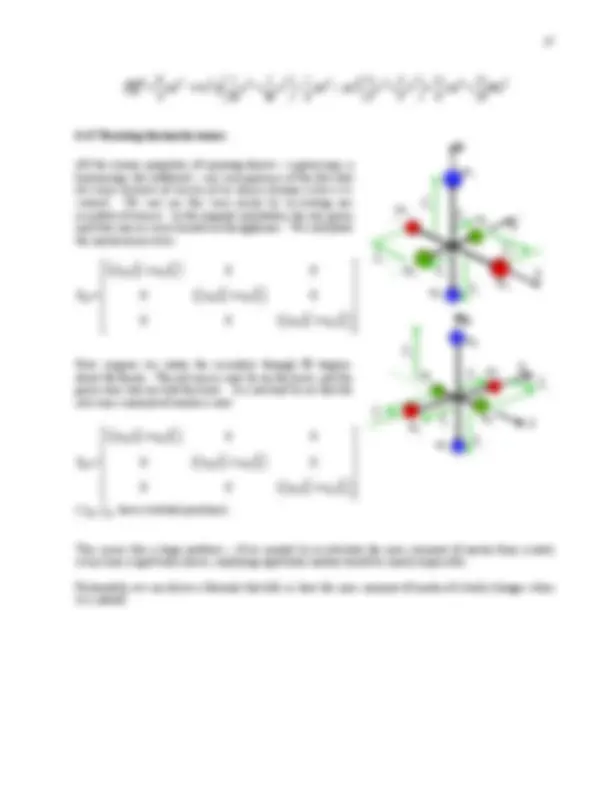
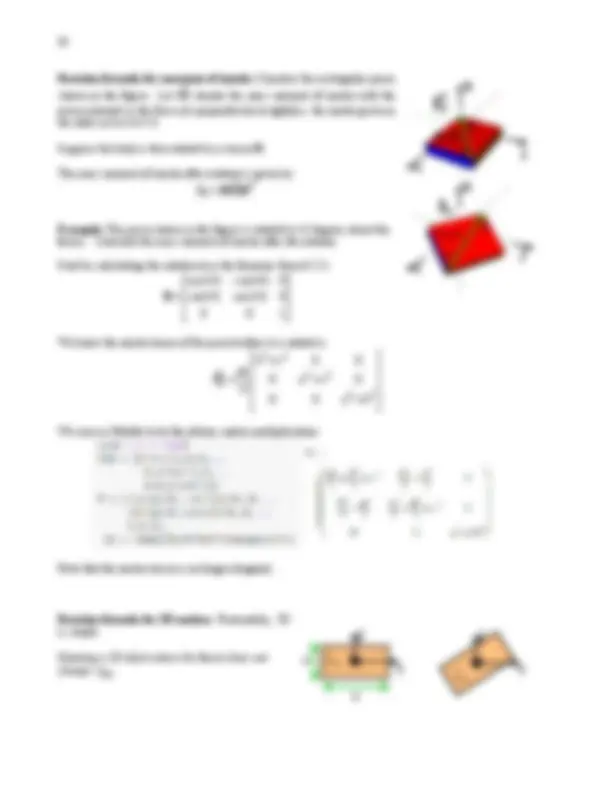
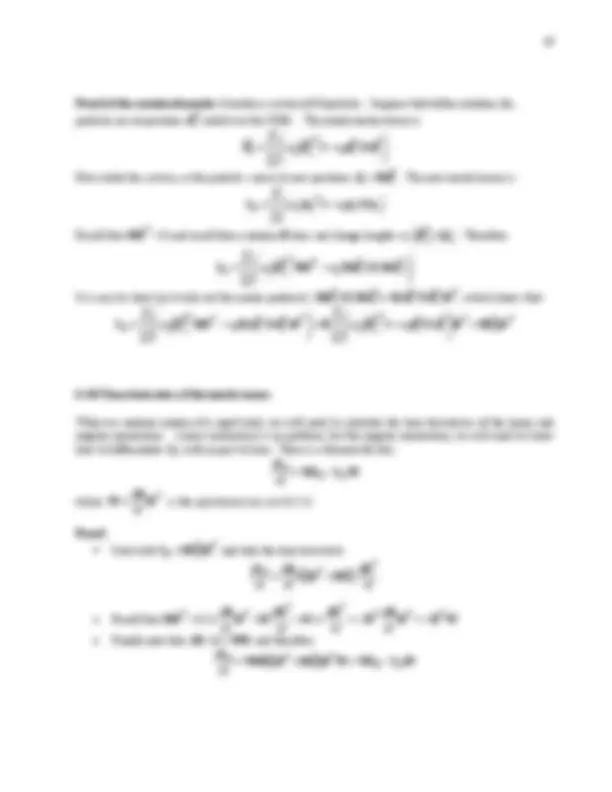
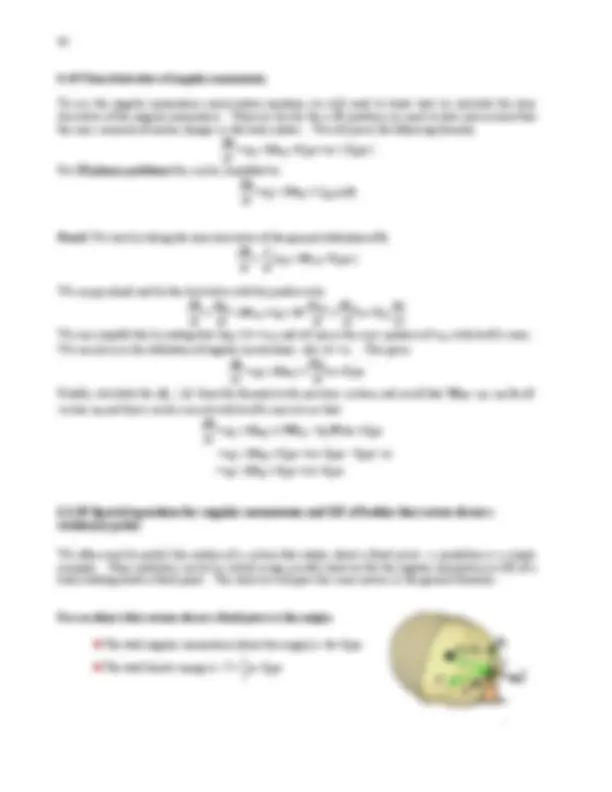
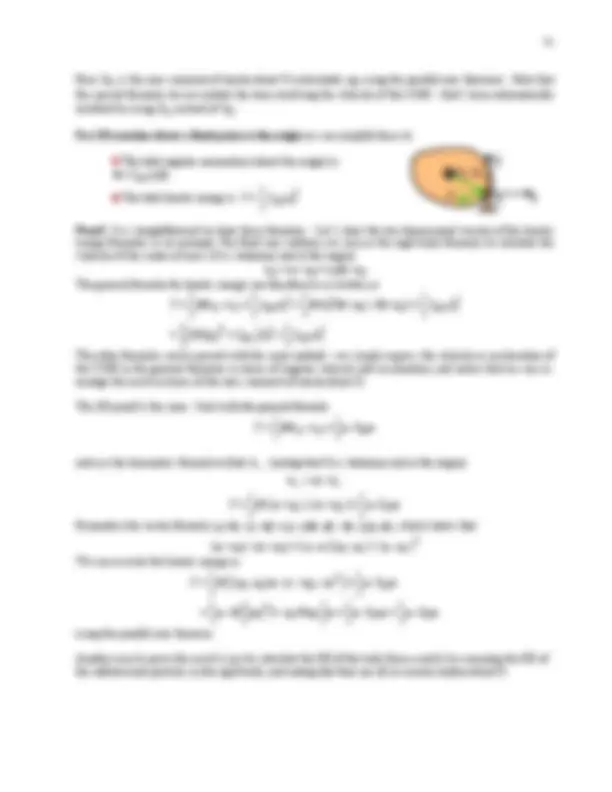
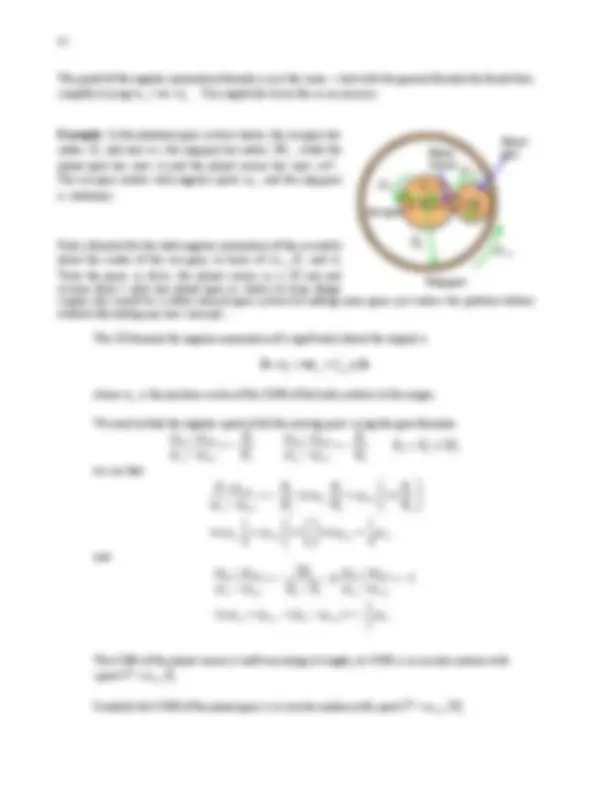
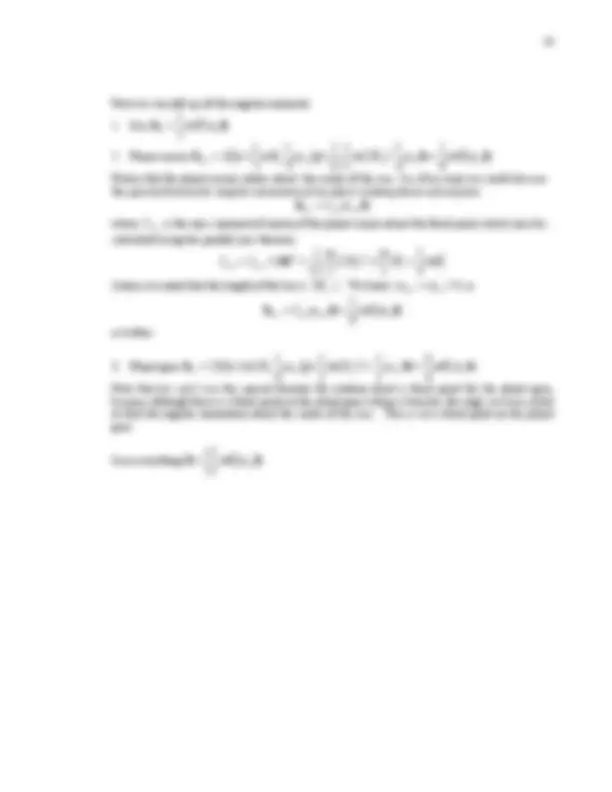
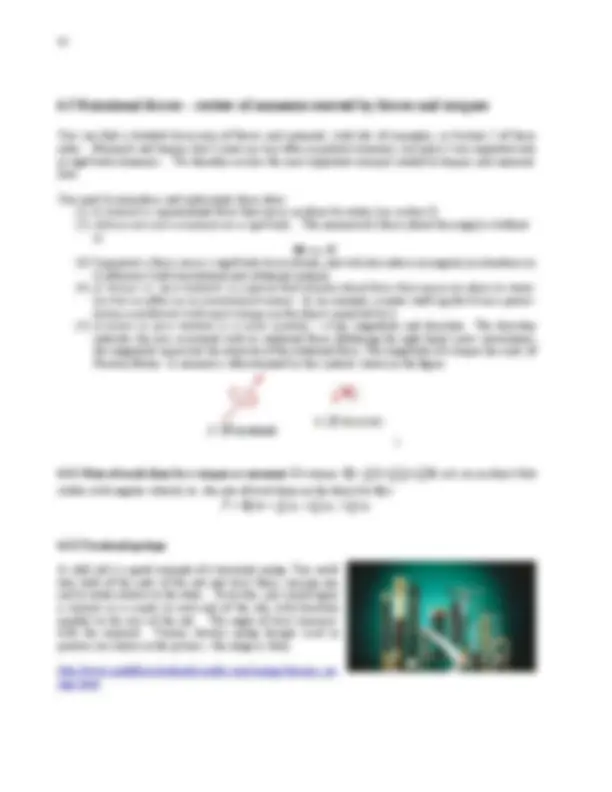
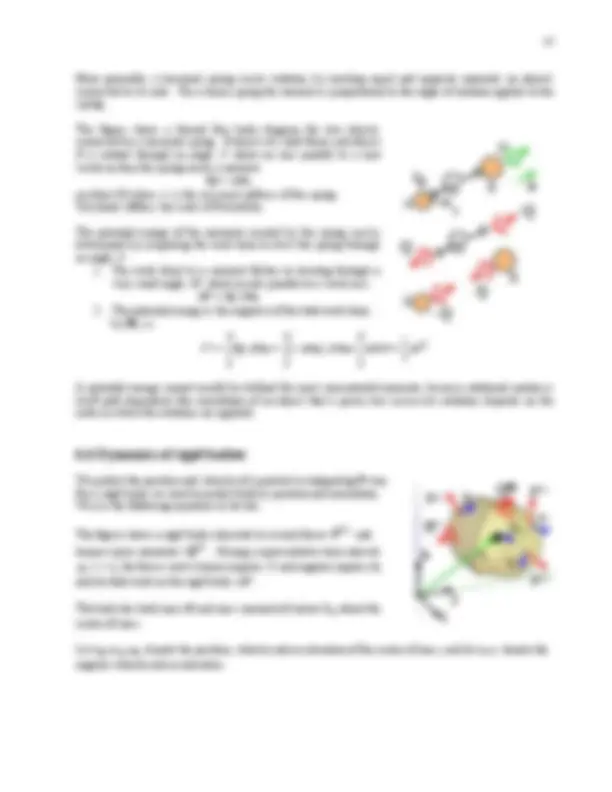
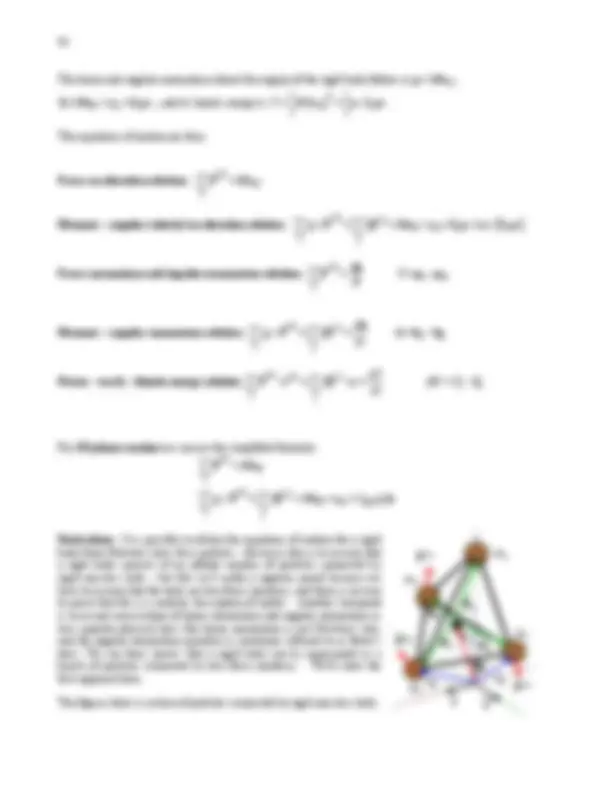
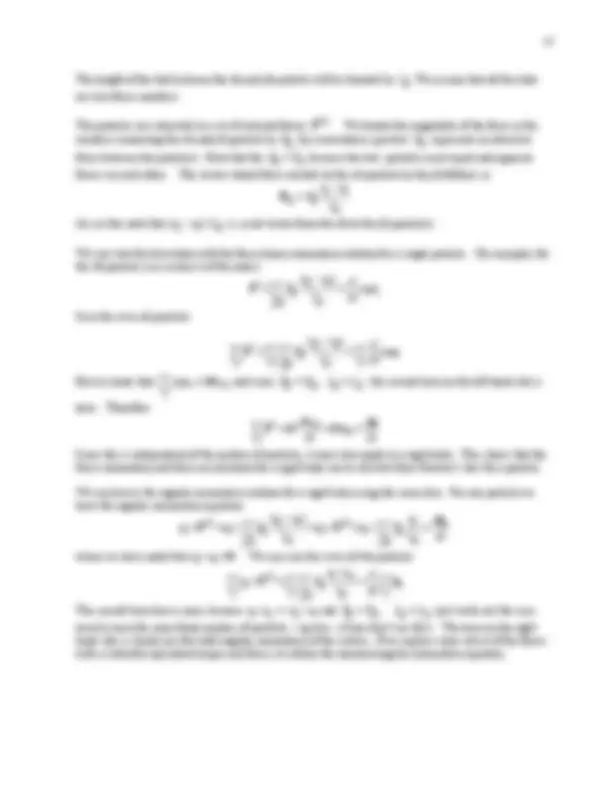
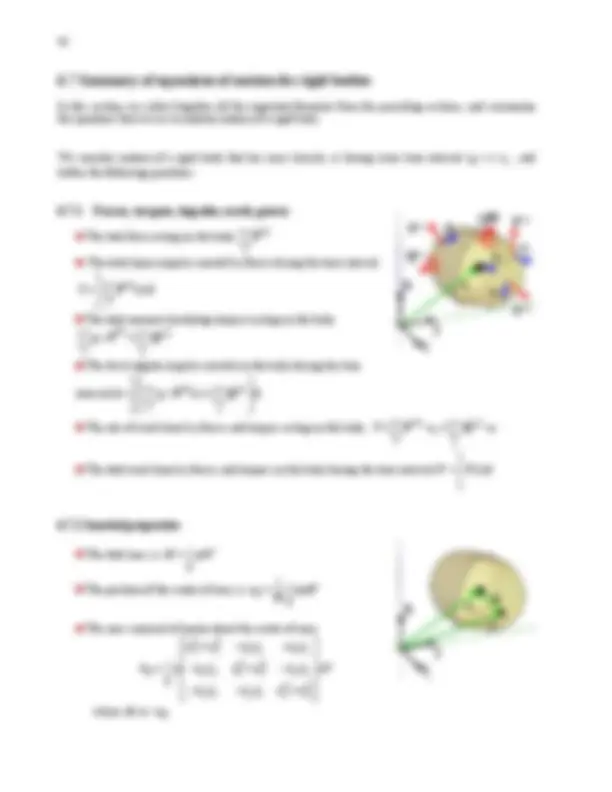
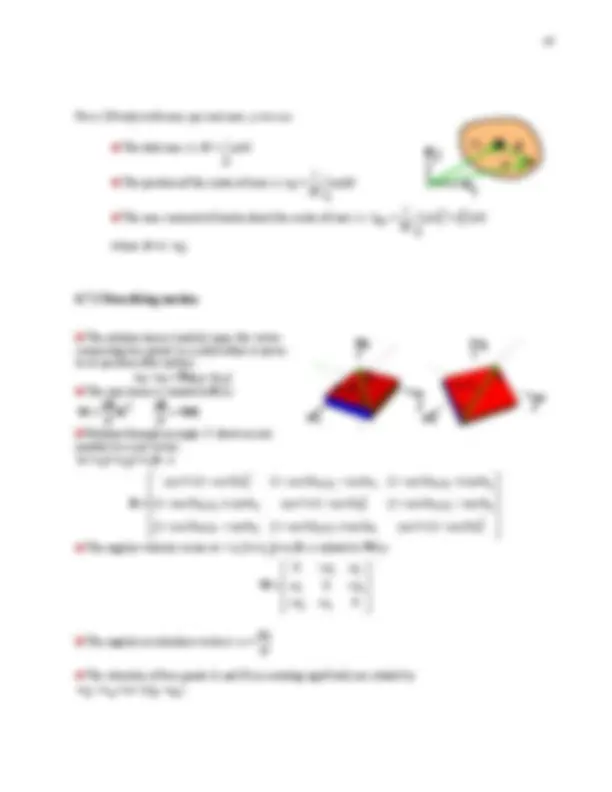
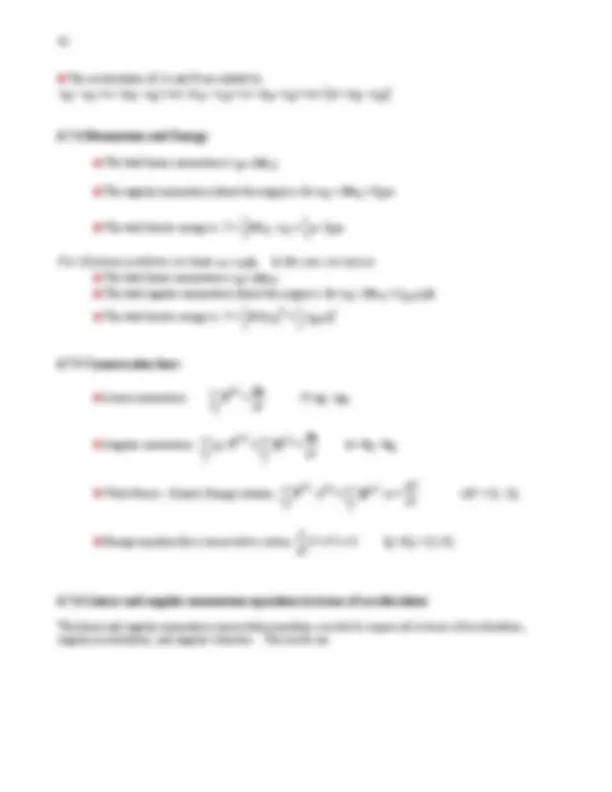
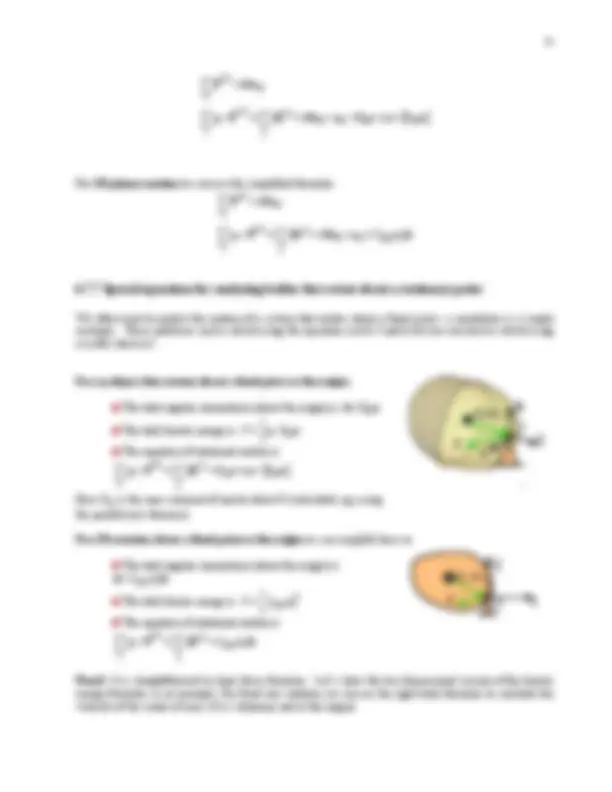
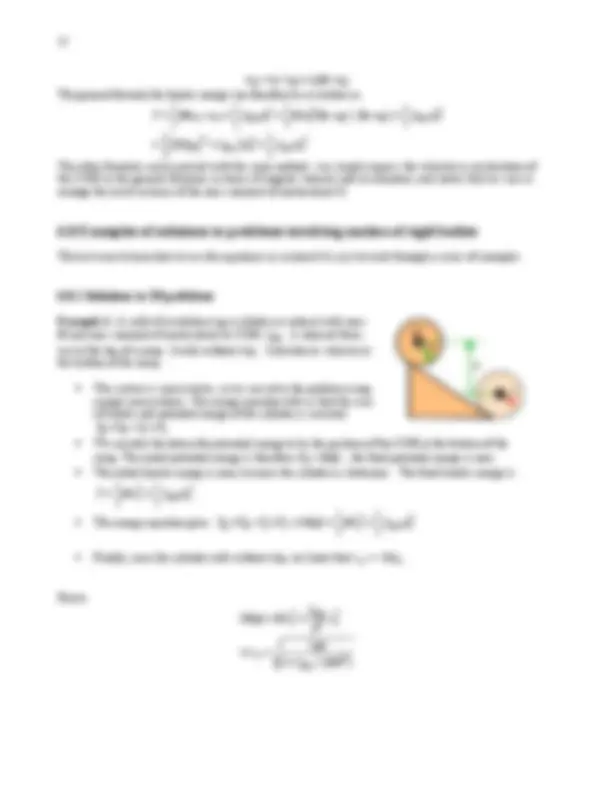
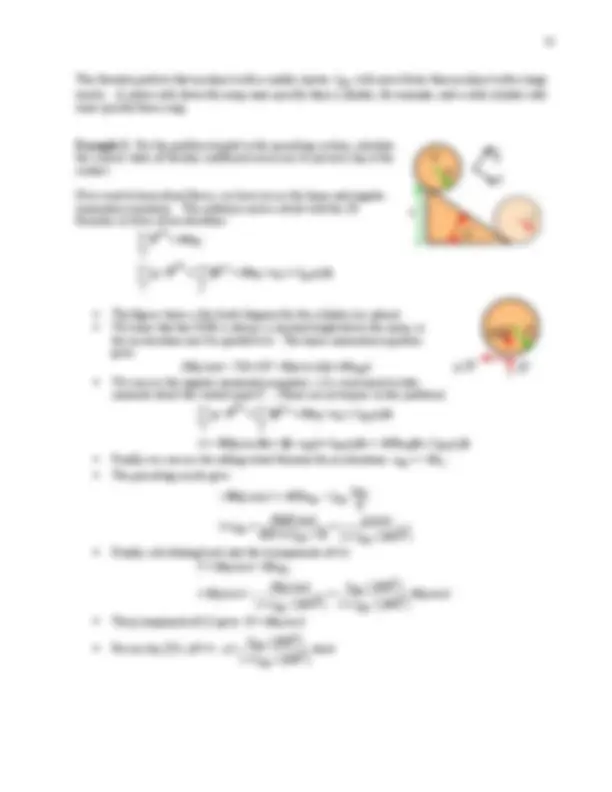
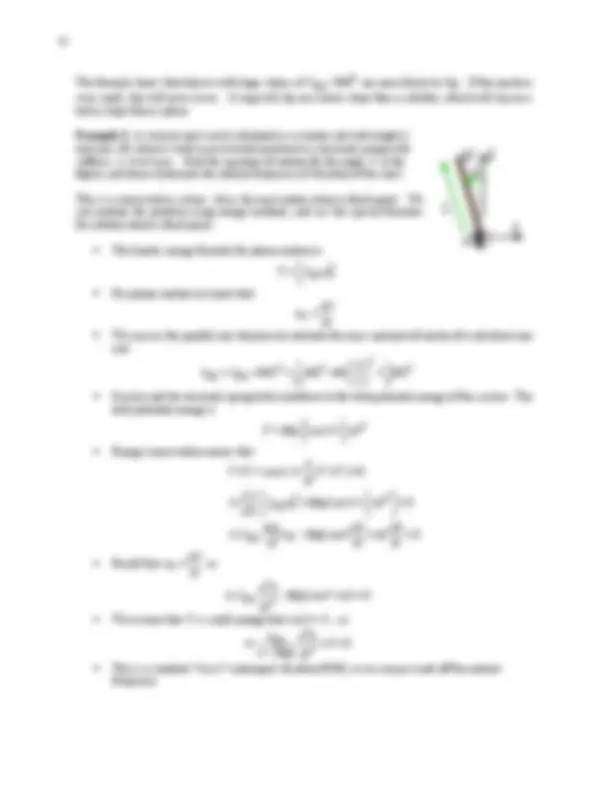
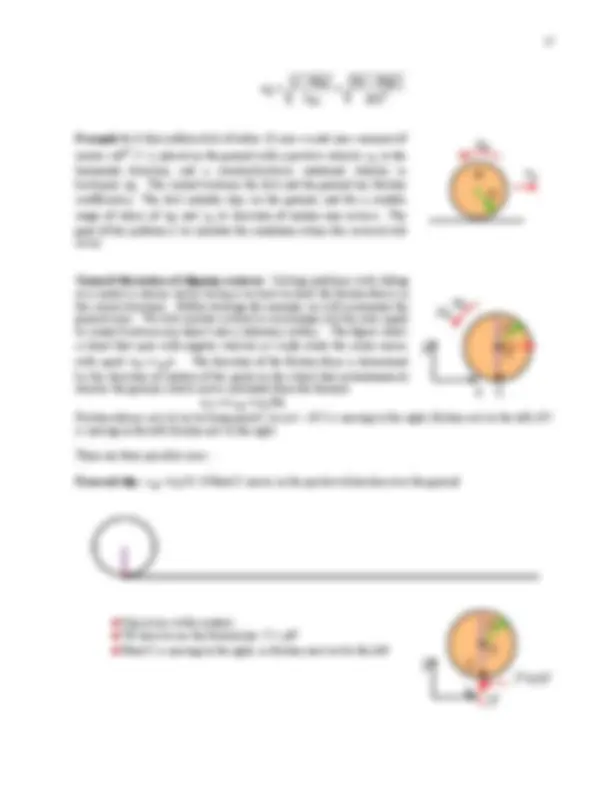
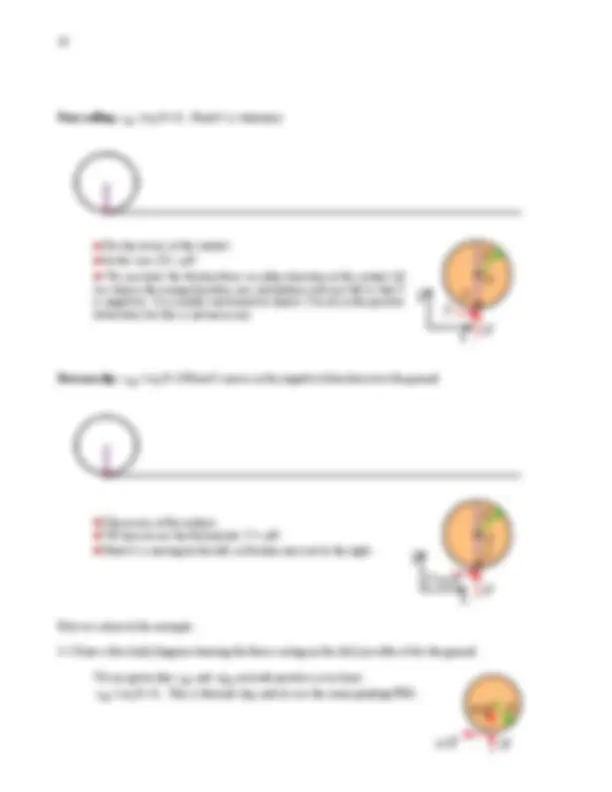
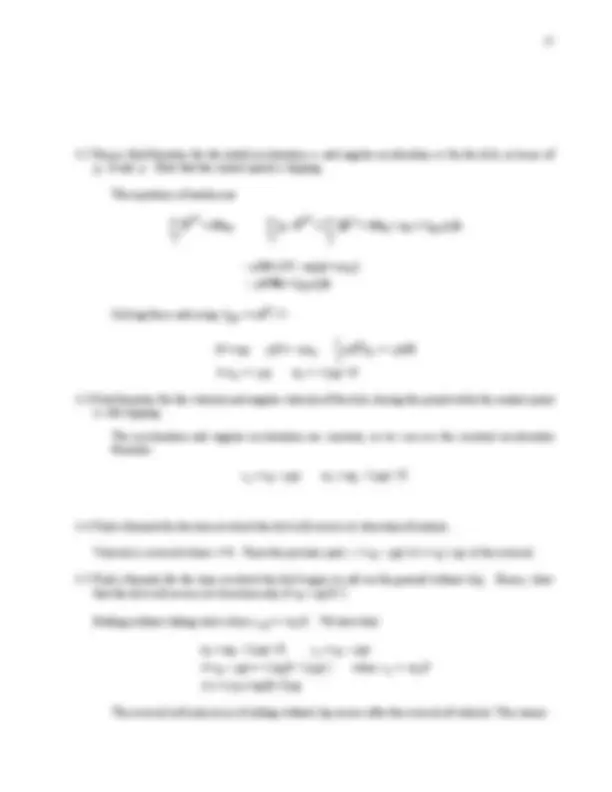
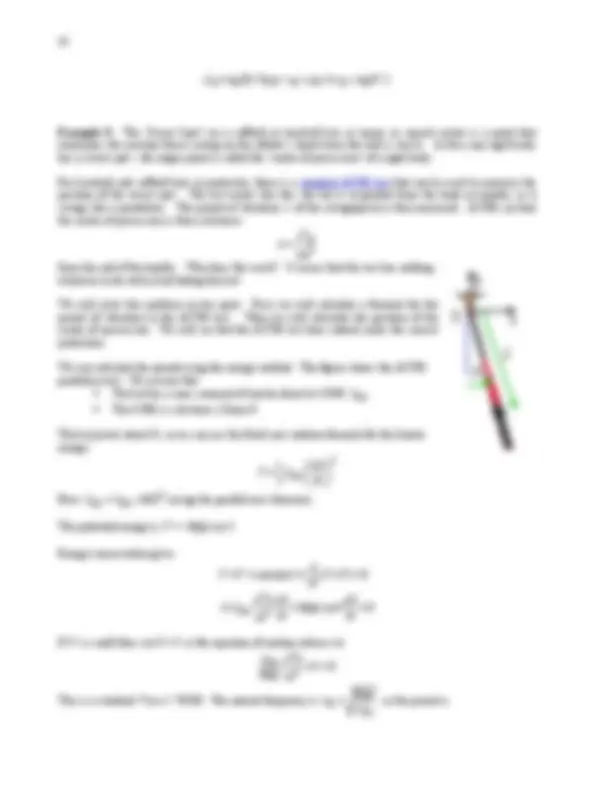
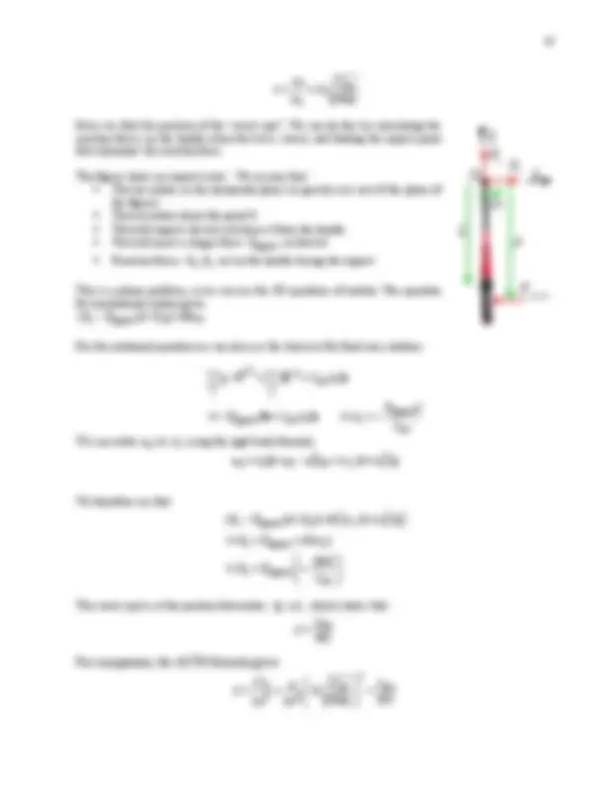
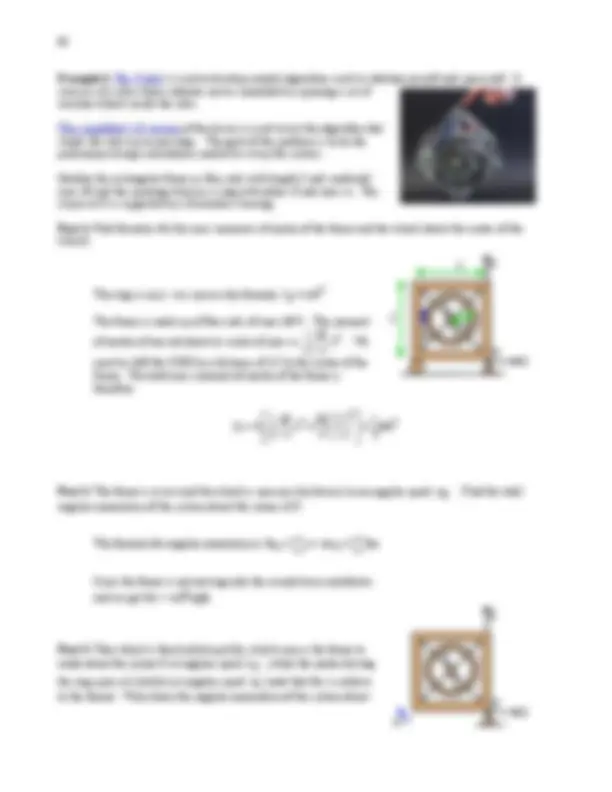
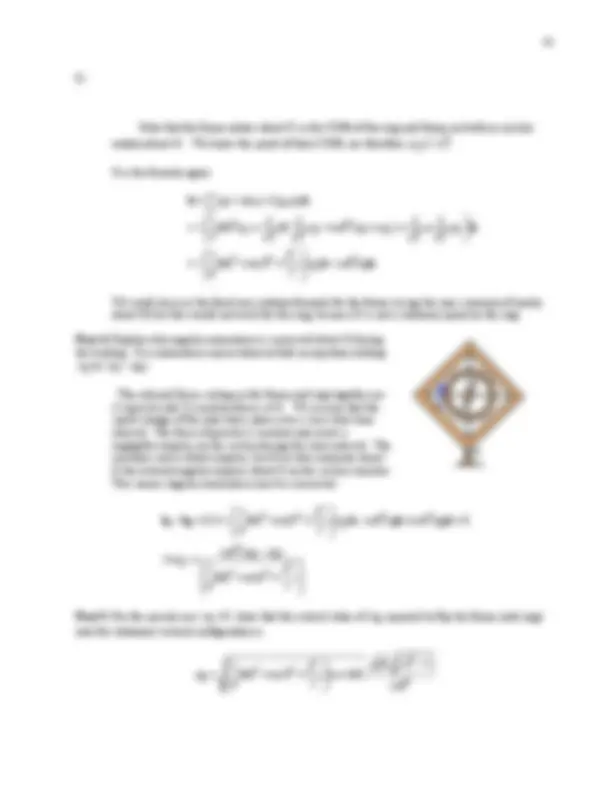
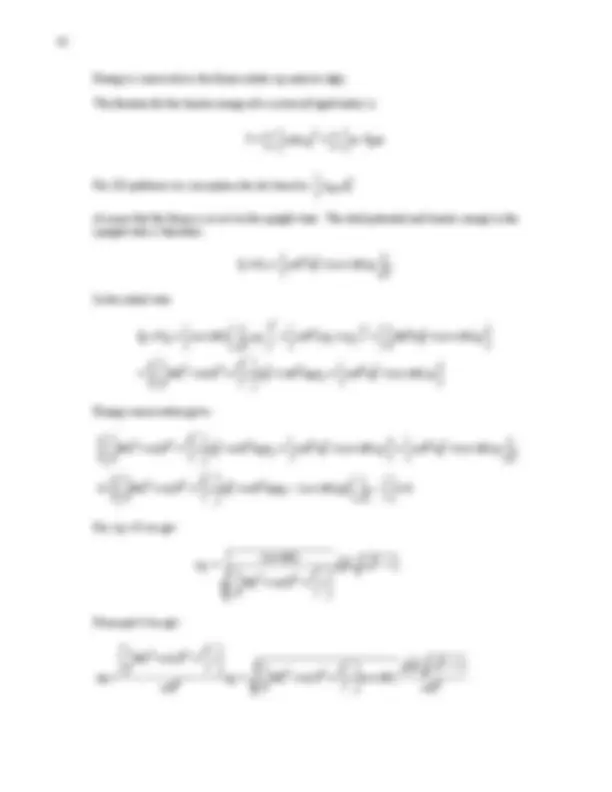
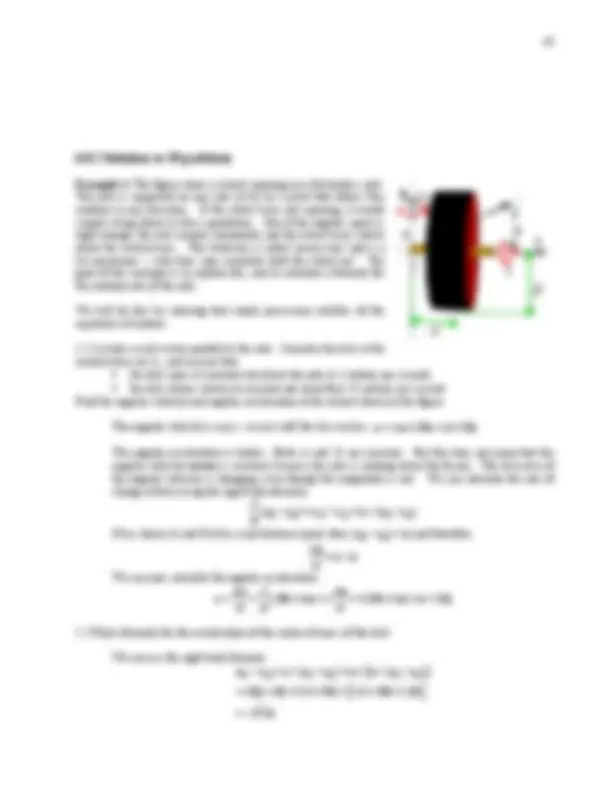
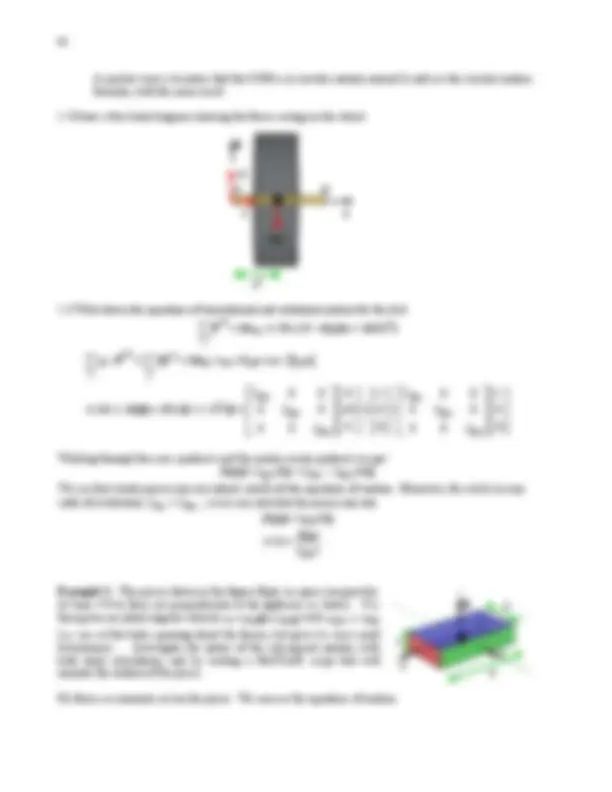
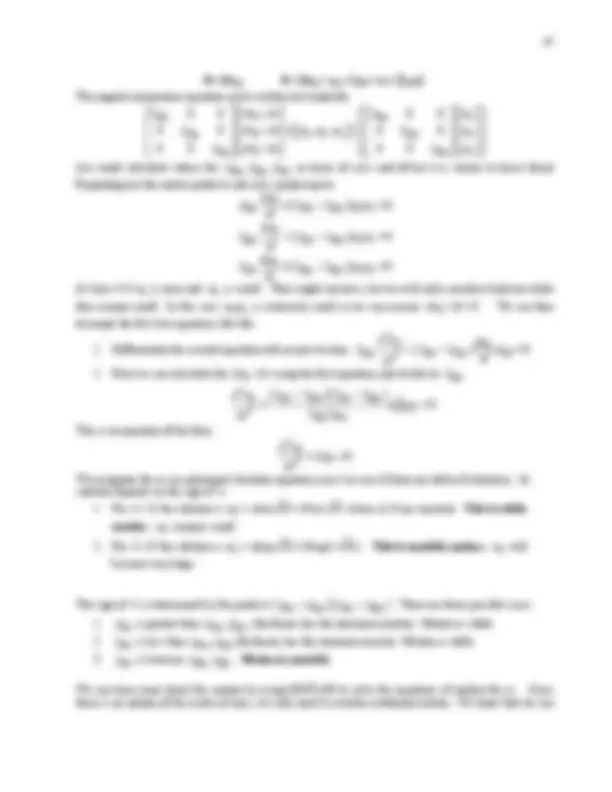
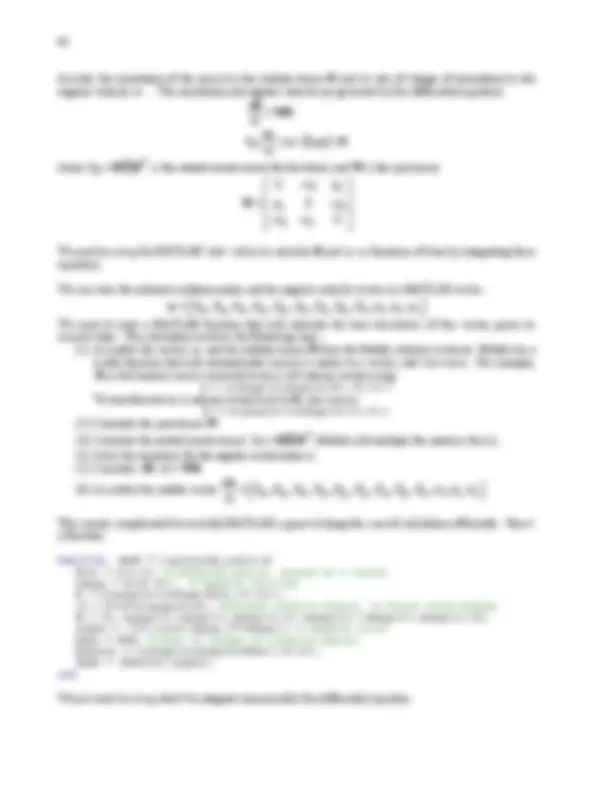
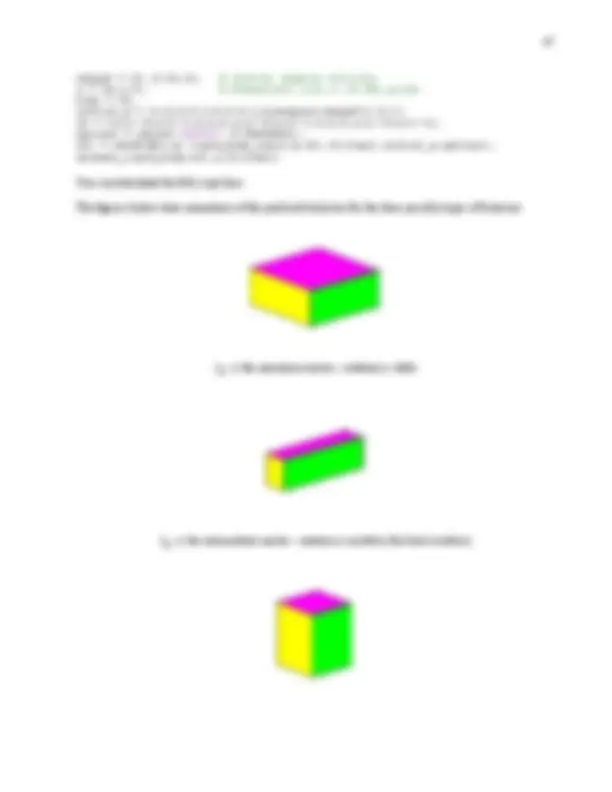



Study with the several resources on Docsity

Earn points by helping other students or get them with a premium plan


Prepare for your exams
Study with the several resources on Docsity

Earn points to download
Earn points by helping other students or get them with a premium plan
Community
Ask the community for help and clear up your study doubts
Discover the best universities in your country according to Docsity users
Free resources
Download our free guides on studying techniques, anxiety management strategies, and thesis advice from Docsity tutors
The fundamental equations and formulas for analyzing the angular momentum and kinetic energy of rigid body systems. It covers the definitions of key inertial properties such as total mass, center of mass, and mass moment of inertia. The document then derives the general expressions for angular momentum and kinetic energy in terms of the angular velocity components. It also discusses the special case of rigid bodies rotating about a fixed point, providing simplified equations for angular momentum and kinetic energy. Additionally, the document covers the time derivative of angular momentum and the equations of motion for a rigid body system. Overall, this document provides a comprehensive theoretical foundation for understanding and applying rigid body dynamics principles.
Typology: Lecture notes
1 / 68

This page cannot be seen from the preview
Don't miss anything!





























































In practice, it is often not possible to idealize a system as a particle. In this section, we construct a more sophisticated description of the world, in which objects rotate , in addition to translating. This general branch of physics is called ‘Rigid Body Dynamics.’
Rigid body dynamics has many applications. In vehicle dynamics, we are often more worried about controlling the orientation of our vehicle than its path – an aircraft must keep its shiny side up, and we don’t want a spacecraft tumbling uncontrollably. Rigid body mechanics is used extensively to design power generation and transmission systems, from jet engines, to the internal combustion engine, to gearboxes. A typical problem is to convert rotational motion to linear motion, and vice-versa. Rigid body motion is also of great interest to people who design prosthetic devices, implants, or coach athletes: here, the goal is to understand human motion, to protect athletes from injury or improve their performance, or to design devices that replicate the complicated motion of a human joint correctly. For example, Professor Crisco’s orthopaedics lab at Brown studies human motion and the forces they generate at human joints, to help understand how injuries occur and how they can be prevented.
The motion of a rigid body is often very counter-intuitive. That’s why there are so many toys that exploit the properties of rigid bodies: the motion of a spinning top; a boomerang; the ‘rattleback’ and a Frisbee can all be explained using the equations derived in this section.
Here is a quick outline of how we analyze motion of rigid bodies.
The force-momentum equation 1
N ext i i i i i
d d m dt dt (^) = ∑ =^ = ∑
p F v
The moment – angular momentum equation 1
N ext i i i i i i i
d d m dt dt (^) =
h r F r v
The work-kinetic energy equation 1
N ext i i i i i i i
dT d m dt dt (^) =
p = M v (^) G h = r G (^) × M v G (^) + I (^) G ω
T = M v ⋅ v + ω I ⋅ ω
where M is the total mass of the body and I G is its mass moment of inertia.
iext G i iext G G G^ [^ G ] i i
∑ F^ =^ M^ a^ ∑ r^ ×^ F^ =^ M r^ ×^ a^ +^ I^ α^ +^ ω^ × I^ ω
We describe motion of a particle using its position, velocity and acceleration. We can describe the position of a rigid body in the same way - we could specify the position, velocity and acceleration of any convenient point in the body (we usually use the center of mass). But we also need a way to describe the orientation of a rigid body, and its rotational motion.
In this section, we define the various mathematical quantities that we use to describe rotation, angular velocity, and angular acceleration.
6.2.1 Describing rotations: The Rotation Tensor (or matrix)
Rotations are quantified by a mathematical object called a rotation tensor. It is defined as follows:
When we solve problems, we always express vectors as components in some basis. When we do this, R becomes a matrix. For example, if p (^) B − p (^) A = x 0 (^) i + y 0 (^) j + z 0 k r B (^) − r A = x i + y j + z k we would write
0 0 0
xx xy xz yx yy yz yz zy zz
x R^ R^ R x y R R R y z (^) R R R z
Here, R 11 (^) , R 12 ,... are a set of nine numbers (or sometimes formulas). Following the usual rules of matrix-
vector multiplication, this is just a short-hand notation for
0 0 0 0 0 0 0 0 0
xx xy xz yx yy yz zx zy zz
x R x R y R z y R x R y R z z R x R y R z
The subscripts on R are meant to you help remember what each element in the matrix does – for example, R xx maps the x 0 onto x, Rxy maps the y 0 onto x , and so on.
(^1) By definition, a ‘second order tensor’ maps a vector onto another vector. In actual calculations R is always just a
matrix, but ‘tensor’ sounds better.
j i
j i
In robotics, game engines, and vehicle dynamics the axis-angle representation of a rotation is often stored as a quaternion. We won’t use that here, but mention it in passing in case you come across it in practice. A
0 cos(^ / 2) x x sin(^ / 2)^ y y sin(^ / 2)^ z z sin^ / 2
q q n q n q n
θ θ θ θ
Mapping the coordinate axes
In some problems we might know what happens to vectors that are parallel to the { i,j,k } directions in the initial rigid body (eg we might know what happens to the sides of our rectangular prism). For example, we might know that { , , i j k }map to (unit) vectors a b c , ,.
In that case we can write down each of a b c , , as components in { , , i j k } a = a x i + a (^) y j + az k b = bx i + by j + bz k c = cx i + c (^) y j + cz k
and use the formula
x x x y y y z z z
a b c a b c a b c
A sequence of rotations
Suppose we rotate an object twice (perhaps about two different axes). How do we describe the result of two rotations? That’s not hard. Suppose we do the first rotation with one mapping (1) (^) ( ) r B (^) − r A (^) = R p (^) B − p A
Now we rotate our body again – this maps (^) r B (^) − r A onto some new vector (^) u B (^) − u (^) A :
( ) (2)( ) u (^) B − u (^) A = R r B (^) − r A
We can therefore write
( ) (2)^ (1)( ) u (^) B − u (^) A = R R p (^) B − p A
We see that Sequential rotations are matrix products
R = R^ (2)^ R (1)
Health warning: Matrix products (and hence sequences of rotations) do not commute
R^ (1)^ R (2)^ ≠ R (2)^ R (1) For example, the figure below shows the change in orientation caused by (a) a 90 degree positive rotation about i followed by a 90 degree positive rotation about k (the figure on the left); and (b) a 90 degree positive rotation about k followed by a 90 degree positive rotation about i (the figure on the right).
j b
k
k
k
j i
i
i
j j
(1) k rotation (2) i rotation
(1) i rotation (2) (^) k rotation
Orthogonality of R
The rotation tensor (matrix) has a very important property: If you multiply R by its transpose, the result is always the identity matrix. Another way to say this is that The transpose of R is equal to its inverse
Let’s try this with the 2D rotation matrix 2 2
2 2
cos sin cos sin cos sin 0 1 0 sin cos sin cos (^0) sin cos 0 1
cos sin cos sin 1 0 sin cos sin cos 0 1
T
T
A matrix or tensor with this property is said to be orthogonal.
Why is this? It turns out that a length-preserving mapping must be an orthogonal tensor. To see this, let’s calculate the length of the rotated vector r B (^) − r A (^) = R p ( (^) B − p (^) A ). We need to remember two vector/matrix
operations:
This means
( r B^ −^ r A^ ) (⋅^ r B^ −^ r A^ ) =^ { R p (^^ B −^ p^ A )} {^ ⋅^ R p (^^ B −^ p^ A )}^ =^ (^ p^ B −^ p^ A )^ ⋅^ { R T^ R p (^^ B − p A )}
But we want the length of r B (^) − r A to equal the length of p B (^) − p (^) A , which means we need R to satisfy
(2) (1)
We can calculate the axis and angle of this rotation using the formulas
1 2cos 2cos 2
cos cos cos 1 cos 1 cos 1 cos 1 ( 1) 0 ( 1) 0 ( 1) 1 1 ( 1) 1 ( 1) 1 ( 1) (^2)
xx yy zz
xx yy zz
n i j k
i j k j k
To decide which of these two choices to use we notice that R (^) yz = − 1 , which tells us that n ny z < 0. The answer is
therefore 1 , ( ) 2
It is incredibly difficult to visualize the effect of a rotation about an arbitrary axis (at least for me). In fact this formula looks wrong – how can a 180 degree rotation end up tipping the box on its side? But the answer is right, as the animation (which will only show up in the html version of the notes) shows.
6.2.2 Describing rotational motion: The angular velocity vector and spin tensor
We described the location of a particle in space using its position vector, and its motion using velocity. We need to come up with something similar to velocity for rotations.
Definition of an angular velocity vector Visualize a spinning object, like the cube shown in the figure. The box rotates about an axis – in the example, the axis is the line connecting two cube diagonals. In addition, the object turns through some number of revolutions every minute. We would specify the angular velocity of the shaft as a vector
rotation
to rotate clockwise. Or conversely, if n points towards you, the shaft appears to rotate counterclockwise. (This is the `right hand screw convention’)
Viewed along n Viewed in direction opposite to n
you know the revs per minute n turned by the shaft, the number of radians per sec follows as
The angular velocity vector is then
As always, in two dimensions, everything is very simple. In this case objects can only rotate about the k axis, and we can write the angular velocity vector as d dt
ω = k
Writing down angular velocities:
For 2D problems, we always know the direction of the angular velocity and can just use ω = ω z k to write it
example:
Example: The propeller on the aircraft shown in the figure spins (about its axis) at 2000 rpm. The aircraft travels at speed 200 km/hr in a turn with radius 1 km. What is the angular velocity vector of (i) the body of the aircraft, and (ii) the propeller? Express your answer in the normal-tangential- vertical basis.
(i) The circumference of the circle is
There is an important formula relating W and ω. Let r B (^) − r A be a vector joining any two points in a rigid
body. Then W r ( (^) B (^) − r A (^) ) = ω × ( r B (^) − r A )
You can see this by just multiplying out the definition of W and comparing the result to the cross product: if r B (^) − r A (^) = x i + y j + z k , then
z y y z B A z x z x y x x y
x z^ x y x z z y x
W r r
Hopefully you can see that this is the same as the cross product!
6.2.3 The angular acceleration vector
Angular acceleration is the time derivative of angular velocity d dt
ω α
For 3D, we can use
x y z x y z
d d d dt dt dt
For 3D, we can’t express the angular accelerations or velocities as derivatives of rotation angles, because these can’t be defined for a general motion.
For a 2D problem, the direction of angular velocity and acceleration are known, so we have
The components are related by 2 2
z z z z
d d d dt (^) dt d
For 2D problems, we can use all the usual rules of calculus to go from angular acceleration to angular velocity to angle, and vice-versa (just like distance-speed-acceleration formulas for straight line motion).
6.2.3 Relative velocity and acceleration of two points in a rigid body
We now know how to describe rotational motion. Our next order of business is to discuss a couple of very important formulas that we use to analyze the motion of a system of rigid bodies, and also to derive formulas for the angular momentum and kinetic energy of a rigid body..
Consider a rigid body: Let ω be the (instantaneous) angular velocity of the body, and W the corresponding spin tensor
Let A and B be two arbitrary points in a rigid body, and let r A (^) , r B and v (^) A , v B , a (^) A , a (^) B be their (instantaneous) position, velocity and acceleration vectors.
Then the relative position and velocity of A and B are related by ( ) ( )
B A B A B A B A
v v ω r r v v W r r
The relative acceleration of A and B are related their relative positions and velocity by a B (^) − a (^) A = α × ( r B (^) − r A (^) ) + ω × ( v (^) B − v (^) A ) = α × ( r B (^) − r A (^) ) + ω × (^) [ ω × ( r B (^) − r A )]
For 2D problems only: we can simplify these, because we know ω is always parallel to the k direction. Therefore
Proof: These fornulas are easy to prove. Remember the mapping:
B A^ (^ B A )^ B A (^ B A )^ (^ B A )
d d dt dt
r r R p p v v r r p p
Also, r B (^) − r A (^) = R p ( (^) B (^) − p (^) A ) ⇒ R T^ ( r B (^) − r A (^) ) = R T R p ( (^) B − p (^) A ) = ( p B (^) − p A )
Hence
B A T^ (^ B A )^ (^ B A )
d dt
v v R r r W r r
Remember that W r ( (^) B (^) − r A (^) ) = ω × ( r B (^) − r A ), so the acceleration formula then follows as
d d d dt dt dt
ω a a v v r r ω r r α r r ω v v
The formulas in 6.2.3 are used to analyze motion in machines. A typical problem is illustrated in the figure. An actuator moves point B on the car jack shown in the figure horizontally with constant velocity V. What are the velocity and acceleration of the platform (CF)?
You could probably solve this rather simple example with elementary trig, but we need a more systematic method for general problems, especially to analyze 3D motion. Here’s the general procedure
θ
C B zBC C B zAB C B zBC C BC zBC
a a k r r r r k i j 0 a j i j
zBC zBC C
⇒ a = i
Example 2: For a more complicated example, we can solve the car jack problem posed at the start of this section. An actuator moves point B on the car jack shown in the figure horizontally with constant velocity V. What are the velocity and acceleration of the platform (CF)?
The system contains 3 rigid bodies (AC, BD, CF^3 ). We don’t know the angular velocities or accelerations of any of
ω (^) zBD ω (^) zCF , α (^) zAC , α (^) zBD α zCF
Calculating the velocity:
E A zAC E A E B zBD E B
ω ω
v v k r r v v k r r
zAC zBD zAC zAC zBD zBD
k i j i k i j i j i j
sin sin cos cos 2 sin cos cos 0 / (2 sin ) / (2 sin )
zAC zBD zAC zBD zAC zAC zBD
(^3) You may be wondering why only a single point was defined at C and E, but there are two points at D and F. That’s
because at C and E the members are pinned together, but there is a roller at D. At E, members AC, BD always have the same velocity and acceleration – we can just use a single variable to denote the velocity of this point. The same is true at C. Members CF and BD touch at F and D, but point D on AB does not have the same horizontal velocity as point F CF, so we need to be able to distinguish between them.
θ
( ) (2 cos 2 sin ) cot 2 sin
( ) (2 cos 2 sin ) cot 2 sin
C A zAC C A C
D B zBD D B D
v v k r r v k i j i j
v v k r r v i k i j j
F C zCF F C F V^ V^ zCF L
ω θ ω θ
v v k r r v i j j
F D zCF zCF
v j v j
Calculating the acceleration.
2
E A zAC E A zAC E A
E B zAD E B zAD E B
α ω
α ω
a a k r r r r
a a k r r r r
2
2
2
( cos sin ) ( cos sin )
( cos sin ) ( cos sin )
( cos sin ) ( cos sin )
( cos sin ) ( cos sin )
zAC zAC
zAD zAD
zAC zAC
zAD zAD
α θ θ ω θ θ
α θ θ ω θ θ
α θ θ ω θ θ
α θ θ ω θ θ
k i j i j
k i j i j
j i i j
j i i j
2 2
2 2 2 2 2 2 3
2 2 3
sin cos sin cos
cos sin cos sin
2 sin cos (cos sin ) cos / (4 sin )
cos / (4 sin )
zAC zAC zAD zAD
zAC zAC zAD zAD
zAC zAD zAC zAC
zAD zAC
α θ ω θ α θ ω θ
α θ ω θ α θ ω θ
α θ θ ω θ θ ω α θ θ
α α θ θ
n A (^) B
t
6.3.2 The Rolling Wheel
Wheels are everywhere. They can be analyzed using the general rigid body equations, but it’s helpful to be able to avoid all the tedious cross products. In this section we summarize special formulas for velocity and acceleration of points on a wheel.
Motion of a wheel rolling without slip on a stationary surface
It is surprisingly difficult to visualize the motion of a wheel. The figure above might help: it shows the trajectory of one point on the circumference of the wheel. The point traces quite a complicated path. The important thing to notice is:
If a wheel rolls without slip on a stationary surface, the point touching the surface is stationary
Each point is only in contact with the ground for an instant, and while it touches the ground it has a large vertical acceleration, but it is instantaneously stationary. We know this from the list of constraints in Sect 6.3.1, of course, but it’s still not an easy thing to visualize.
More generally, the ground need not necessarily be stationary (or the wheel could touch another surface). In this case we know that the contacting points on two bodies in rolling contact have equal velocity at the contact****.
Angular velocity-linear velocity formula: With this insight, we can use the rigid body formulas to calculate the instantaneous velocity vector for any point on the wheel. Assume that
The rolling wheel formula gives
To see this, you can simply use the rigid body formula to go from the contact point (which is stationary) to O v O (^) − v (^) C = ω × ( r O (^) − r C (^) ) ⇒ v O (^) = ω z k × ( R j ) = −ω zR i
More generally, we can calculate the velocity of any point on the wheel we might be interested in. In fact, we can just write down the velocity of any point in the wheel by noticing that instantaneously all points are in circular motion about the contact point (just imagine the disk is rotating about C). See if you can show all the following:
Notice that the direction of the velocity at each point is always perpendicular to the line connecting to the point to C.
Angular acceleration-linear acceleration formula: Assume that
The rolling wheel formula gives a xO = − α zR
You can derive this formula in two different ways:
(2) Use the rigid body formula: 2
2
( (^) O C ) ( (^) O C ) (^) z ( (^) O C )
O C z R^ zR
ω
α ω
a a α r r r r
a a i j We know that the i component of acceleration at point C has to be the same as the i component of acceleration of the ground (i.e. zero). (The j components don’t have to be equal). We also know that O has no j acceleration, because it remains at the same height above the ground. Therefore 2
2
xO yC z z
xO z yC z
a a R R
a R a R
i j i j
We can calculate the acceleration of any other point on the disk using the rigid body formula.
Example: The block AB has horizontal acceleration a and horizontal speed v. Calculate the angular velocity and angular acceleration of the rollers. Then, calculate the linear velocity and acceleration of O
To solve problems like this we use two ideas: (1) the formulas relating velocity and accelerations of points on the disk; and (2) the tangential velocity and acceleration of contacting points are equal.
θ
Example 1: The left gear in the figure rotates with counterclockwise
small one has radius R 2 and N 2 teeth. Calculate the angular velocity
of the smaller gear.
Note:
z z z
Notice that we assume both gears rotate counterclockwise. The formula tells us that the second gear has a negative angular velocity – this means that it is actually rotating clockwise. The animation at the top of this section confirms that this indeed is the case.
Example 2: An ‘epicyclic’ gearbox is a special arrangement of gears that has many applications. The sketch shows a simple example. The gearbox can be driven in three different places: one drive shaft is connected to the central sun gear (A); the other is attached to the ‘planet carrier’, which is joined to the center of the ‘pinion gears’ B,C and D. The outer gear (E – called the ‘ring gear’) can also be driven separately.
Epicyclic gearboxes are used in all automatic vehicle transmissions. They are also very useful in ‘split power’ drives, where two motors need to be connected together to drive a single axle. Hybrid vehicles, which have both an electric motor and an internal combustion engine driving the same axle, are one example. You can find a very nice description of the Toyota Prius split power transmission here: the website includes a Flash animation that lets you change the speeds of the motors in the system and visualize the motion of the gears.
The figure shows a schematic diagram illustrating the general geometry and motion of the system. We have four rigid bodies:
In any application, we are given the angular velocity of two of the drive shafts (any two of
Ring gear
zS
Planet Carrier
Planet gear
This seems a terribly difficult problem, but it can be solved in a very simple way with a trick.
We start by solving a simpler version of the problem. Suppose that the planet carrier is stationary ( ω zPC =0) and the sun gear
rotates with angular speed ω zS (see the animation). What is the
angular velocity of the ring gear?
The sun gear and the planet gear are just a standard gear pair so we know that
S zS S zP zP zS
R r r
The two touching points on the planet gear and the ring gear must have the same velocity, so (using the rotating gear formula)
zP zR R R zP R
r r R R
S zR zS R
This is difficult to analyze because the center of the planet gear is not fixed, so it’s hard for us to visualize the motion, and the standard gear formulas don’t work. But we can simplify the problem by analyzing motion in a reference frame that rotates with the planet carrier. For example, imagine attaching a videocamera to the planet carrier – this camera would show the planet carrier to be stationary, with the surrounding world rotating in the opposite direction. The angular velocity of the planet carrier would be subtracted from all the other angular velocities. In this reference frame, we can use the result we just calculated: ( ) ( )
zR zPC S zS zPC R
ω ω ω ω
This result is general, and can be re-arranged to tell you the